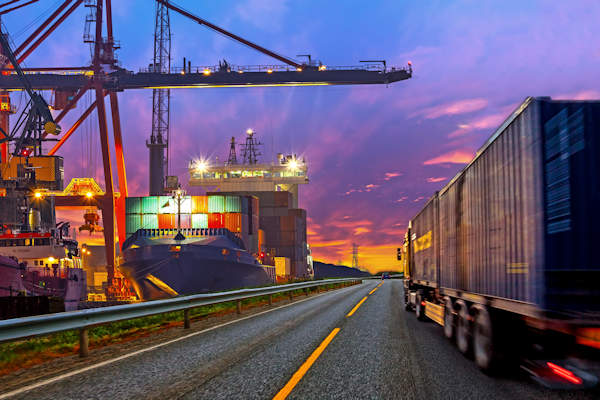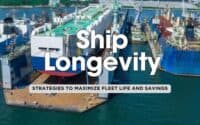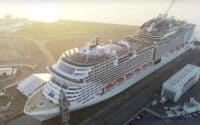Digital Twins and the Future of Cargo Shipping: A Revolution in Maritime Logistics

Definition and Concept:
A Digital Twin, at its core, is a virtual representation of a physical entity or system. It leverages real-time data, simulations, and advanced algorithms to mirror the state, behavior, and context of its physical counterpart. The concept has its roots in computer-aided design (CAD) and manufacturing processes, but with the rise of the Internet of Things (IoT) and big data analytics, its scope and application have expanded exponentially.
* Please send feedback/suggestions to editor @ shipuniverse.com
This digital-physical link enables organizations to monitor the state and health of their assets, predict upcoming issues, optimize operations, and even innovate in design and functionality. A digital twin’s essence lies in its capability to evolve with the entity it represents, allowing for a continuously updated model that mirrors its real-world counterpart.
Brief Overview of Its Application in Other Sectors:
- Manufacturing: Digital twins monitor production lines, predict equipment failures, and optimize the manufacturing process for better quality and efficiency.
- Healthcare: They’re used to simulate the human body’s responses to different treatments, allowing for personalized medicine and optimized patient care.
- Urban Planning: Cities are leveraging digital twins to manage infrastructure, traffic systems, and energy grids, resulting in smarter, more efficient urban environments.
- Aerospace: Aircraft manufacturers employ digital twins to monitor airplane systems in real-time and simulate conditions for better design and safety measures.
Digital Twins in Maritime Context
How a Digital Replica of a Ship, Its Systems, Cargo, and Even the Marine Environment Can Be Created:
In the maritime domain, creating a digital twin involves a blend of sophisticated modeling techniques, sensor data, and computational technology. High-resolution 3D scans of ships are merged with architectural plans and designs, providing a foundational digital structure. Embedded IoT sensors throughout the ship continuously collect data on everything from engine performance and hull stress to cargo conditions and ambient environmental factors. Even factors like wave height, salinity, and marine life can be integrated into the digital twin for a holistic maritime view.
The Interplay of IoT Sensors, AI, and Big Data in Building a Comprehensive Digital Twin:
The heartbeat of a maritime digital twin is the vast array of IoT sensors scattered throughout the ship. These sensors continuously feed data into a centralized system. AI algorithms then analyze this data flood, distinguishing patterns, anomalies, and potential areas of concern. For instance, subtle changes in engine vibrations might suggest potential maintenance needs, while shifts in cargo temperature might indicate a malfunctioning refrigeration unit.
Moreover, as this data is accumulated over time, big data analytics come into play, offering insights into long-term wear and tear, optimal routes based on past experiences, and more. The combination of IoT’s real-time data collection, AI’s predictive power, and big data analytics’ macro-level insights ensures that the digital twin is not just a passive reflection but an active, analytical tool enhancing maritime operations.
Benefits to the Cargo Shipping Industry
1. Optimized Routes: With the power of predictive analytics, digital twins can sift through historical data and real-time conditions to determine the most efficient sailing routes. This optimization takes into account factors like weather patterns, currents, and even potential geopolitical events. By predicting and avoiding rough seas or unforeseen barriers, ships can not only conserve fuel but also ensure timely deliveries and enhanced safety for the crew.
2. Maintenance Predictions: Wear and tear on a vessel are inevitable. However, with continuous monitoring and data analysis, digital twins can pinpoint which parts of a ship are likely to require maintenance next. This proactive approach reduces unexpected downtimes, extends the lifespan of equipment, and can significantly cut down on repair costs.
3. Efficient Cargo Management: By monitoring cargo conditions in real-time, digital twins can ensure that products – especially perishables or sensitive goods – are kept in optimal environments. This real-time insight helps in minimizing damage, spoilage, and subsequent financial losses. Additionally, real-time data can aid in efficient loading and unloading processes at ports.
4. Sustainability and Fuel Efficiency: A significant challenge in the maritime industry is its environmental impact, particularly emissions. Digital twins, through simulations and analyses, can suggest modifications in ship design or operational changes that enhance fuel efficiency. Over time, these data-driven tweaks can lead to substantial fuel savings and a significant reduction in greenhouse gas emissions.
5. Enhanced Security: The vast oceans are not always safe, with threats like piracy still a concern in certain regions. Digital twins can offer continuous monitoring and employ predictive threat analysis, helping ships avoid potentially unsafe zones. In the event of suspicious activity, alerts can be sent in real time, enabling quicker response times.
Challenges and Concerns
1. Data Privacy and Security: As with any system that collects, stores, and analyzes data, there are concerns about data breaches and unauthorized access. Ensuring that sensitive information, especially regarding cargo details or operational specifics, remains secure is paramount.
2. Initial Investment and the Need for Skilled Personnel: Setting up a digital twin, with its associated IoT infrastructure and analytics systems, can be capital intensive. Additionally, maintaining and extracting value from this system requires a workforce skilled in data analytics, AI, and maritime operations – talents that might be in short supply.
3. Integration with Legacy Systems: Many vessels and ports still run on older technological infrastructures. Integrating digital twins with these legacy systems can be complex and, in some cases, might demand significant overhauls to existing processes and hardware.
As we set our sights on the horizon of the next decade, the maritime cargo shipping industry stands at the cusp of a digital revolution. The broader adoption of digital twins, as illuminated, promises a future where the intricate dance of global logistics becomes a symphony of precision, predictability, and proactive problem-solving.
Digital twins, with their virtual mirroring of the physical world, are much more than just digital replicas. They represent a paradigm shift in how we approach, understand, and optimize vast systems like cargo shipping. By continuously monitoring and analyzing the myriad elements at play, these dynamic models hold the promise to elevate every facet of maritime operations.
In terms of efficiency, gone will be the days of reactive measures and unexpected downtimes. The digital foresight provided will streamline routes, manage cargo impeccably, and ensure that the enormous machinery of ships remains in peak condition. This efficiency, in turn, dovetails into heightened sustainability. As the world grapples with the pressing challenge of climate change, the cargo shipping industry, traditionally seen as a significant emitter, can pivot to become an exemplar of green operations. Digital twins, by guiding fuel-saving routes and advocating design changes, will play a pivotal role in reducing the carbon footprint of ships.
Lastly, this revolution isn’t just about operational finesse or environmental responsibility; it’s also a matter of profitability. Reducing wastage, averting losses from damaged cargo, and optimizing routes will all coalesce to bolster the bottom lines of shipping companies.
In essence, the next decade beckons a maritime world where ships aren’t just vessels of transport, but interconnected, intelligent entities navigating the challenges of the seas with digital acumen. The embrace of digital twins might very well chart the course for an industry that is smarter, greener, and more profitable, shaping a brighter future for global commerce.

Do you have a Maritime Product or Service that may be of interest to Shipowners? Tell us about it here!
Do you have feedback or insights? Please reach out to editor @ shipuniverse.com



